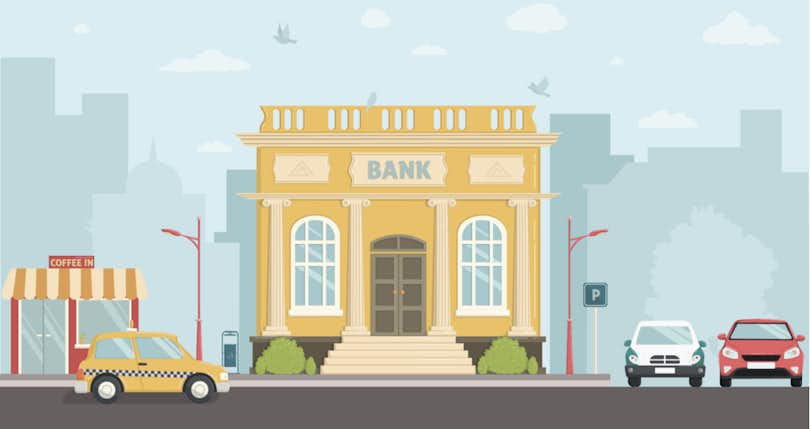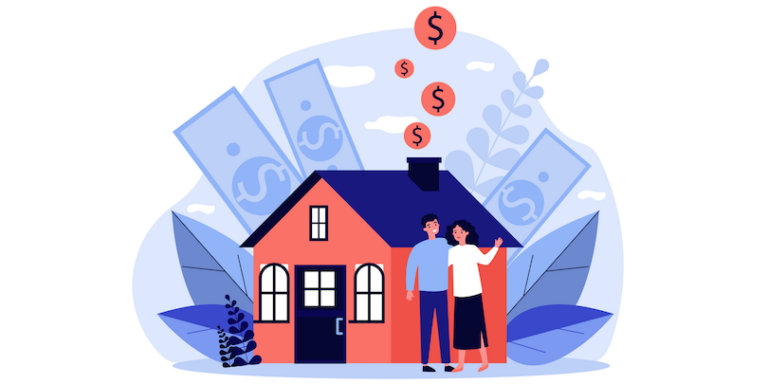
While the Great Recession technically only lasted two years (2007-2009), its disastrous effects stretched much longer. A major contributor to the crash was a deceptively unstable mortgage market.
The economy seemed strong, interest rates were low, and mortgage lenders were open to lending to subprime candidates, meaning more people could own a home. The American Dream was on the horizon for many who would have otherwise missed out on such a huge milestone. Investors were convinced homes would continue to appreciate in value, despite the warning signs.
However, a spike in subprime mortgages also meant banks were lending to risky borrowers, who are more likely to default on their loan payments. Leading up to the financial crisis were loads of red flags like this coupled with economic growth, leaving many suspicious of recent growth, wondering whether another crash is unavoidable.
Today, the median home value is around $243,000 (compared to $197,000 in 2009), and homeownership rates are beginning to increase after the sub-crisis drop. As home values and purchases continue to rise, so does the total mortgage debt in the U.S. At the end of 2019, Americans held over $9.5 trillion in mortgage debt — officially surpassing 2008 levels of mortgage debt.
People — especially younger generations — carry much more debt and have less wealth than older generations at the same age and are participating in financially questionable purchases (like buying a home with almost no money in savings).
According to the Fed, baby boomers owned about 21% of the nation’s wealth in 1989 when they were 25-34 years old. Millennials in 2019 (who are about 23-38 years old) only own 3% of the nation’s wealth. And 30-39 year olds held over 2x as much debt in 2019 than they did in 1999.
To determine whether concerns about another crash are warranted, we investigated the housing and mortgage markets leading up to and since the Great Recession.
The truth is a mixed bag: Credit has tightened, and mortgage lending practices are stricter. Still, mortgage lenders continue to lend to subprime and deep subprime borrowers, and applicants are dealing with new challenges and rising non-mortgage debt.
2008 vs. Today’s Mortgage Market by the Numbers
Key Insights
- The housing market has largely recovered since the 2008 financial crisis, but recent lifts on lending restrictions and low interest rates might put us at risk for market corrections
- While the largest share of mortgage down payments are within the 20% to 40% range, the proportion of down payments less than 20% has increased 75% since 2008
- The average debt-to-income ratio dropped 22% in the decade following the crash, but still remains high (97%)
- The good: A smaller proportion of mortgage applications are approved and loan default risk is only 2.3% (compared to over 16% in 2006), and the average American’s credit score hit all-time high of 703 in 2019
- The bad: Subprime lending has increased 63% since 2010, and banks lent out over $4.18 billion to subprime mortgage borrowers
- The ugly: Americans are $14 trillion in debt, and non-mortgage debt is $1.55 trillion more today than it was in 2008
- Younger borrowers face greater challenges to homeownership in 2020, as student loan debt has reached $1.51 trillion, twice 2008 levels
- While most debt types lower delinquency rates than 2008, auto and student loans have not; both have higher delinquency rates now than they did prior to the recession
- Decreases in mortgage originations are likely a function of the fact that most homebuyers don’t have much in savings to put toward a down payment (inflating LTV) and Americans hold a lot of debt (i.e., high DTI), so tighter restrictions on mortgage lending can lead to fewer homeowners.
- In the 3rd quarter of 2019, U.S. homeowners held $15.8 trillion in real estate equity — on average that translates to nearly 64% of real estate’s value in equity.
Table of Contents
JUMP TO SECTION
- Credit Scores Are at All-Time Highs
- Subprime Lending is on the Rise
- Non-Mortgage Debt is Outpacing Pre-Crisis Levels
- Average American DTI Approaches 95%
- Low Down Payments Have Increased 75% Since 2008
- Fewer Mortgage Applicants
- Historically Low Interest Rates
- Underwater Equity Down to 4% From 26%
- Where You Live is a Big Factor in Homeownership Rates
- Fewer Mortgage Applicants are Approved
Lending Practices
Credit score, debt-to-income (DTI) ratio, and loan-to-value (LTV) ratio are major contributors to a borrower’s risk profile. Higher credit scores and lower DTI and LTV ratios are preferred, but the type of borrowers who are granted mortgages changes over time.
Credit Scores Are at All-Time Highs
Average FICO credit scores reached an all-time high of 703 in 2019, up 20 points since 2009, which is great news for borrowers. The continuous hike in scores is likely due to a variety of factors, including increased credit card use, actively seeking out higher credit limits on accounts, and increased ability to monitor one’s score through free online sources.
The median credit score for people who were approved for mortgages was about 743 in 2003, but in the few years leading up to the financial crisis, lenders were approving subprime borrowers at historically high rates.
The median credit score for borrowers dropped to 707 by the end of 2006 and banks issued mortgages totaling over $192 billion to borrowers with credit scores below 660 just in the first quarter of 2007, nearly 3x the volume just two years prior.
Lending institutions have severely tightened their lending standards when it comes to low-credit borrowers in the post-crisis years. The median borrower’s credit score jumped to 781 by 2011 and has stayed relatively high since.
Subprime Lending is on the Rise
While median credit scores are on the rise, there has been a steady increase in the number of mortgages to borrowers with subprime (credit scores 581-619) and deep subprime (credit scores less than 580) risk scores since 2011, causing concern for many watching the market closely.
The rates still aren’t near pre-crisis levels, and restrictions on lending should prohibit lenders from approving too many subprime and deep subprime mortgages. Recent repeals of post Great Recession restrictions, though, might allow for this trend to continue into dubious territory.
More specifically, Congress signed the Economic Growth, Regulatory Relief, and Consumer Protection Act (more-commonly referred to as the Crapo Bill) that adjusted many regulations set forth by the Dodd-Frank Wall Street Reform and Consumer Protection Act.
The Dodd-Frank Act specified larger reserve amounts for large banks, required semi-annual stress testing, and established the Consumer Financial Protection Bureau, which made the terms of mortgages more transparent for borrowers to reduce predatory lending practices. The law also made it illegal for banks to invest with risky hedge funds and private equity firms, and restricted the ability for proprietary trafding.
According to Harvard Law School, the Crapo Bill was primarily focused on lifting restrictions for smaller institutions, like community banks by allowing more trading options, and increasing the asset-holding threshold for a bank to be considered a "large" or "systemically important financial institution" from $50 billion to $250 billion — dropping many smaller and mid-sized banks from the requirements. Stress testing requirements were also relaxed in that fewer banks need to perform tests and those who do have to do so less frequently.
Non-Mortgage Debt is Outpacing Pre-Crisis Levels
Mortgage lenders heavily scrutinize mortgage borrower debt prior to approving a loan. More specifically, the amount of debt the applicant has compared to their income is weighed against the monthly mortgage payment estimate.
Americans hold quite a bit of debt in the form of mortgages, credit card debt, student loans, and auto debt. In particular, student loan debt has been consistently increasing over the past decades, leaving many younger people in trouble financially and making it more difficult for people to afford homes.
Average American DTI Approaches 95%
High levels of debt accompanied by extraordinarily slow relative wage growth put many Americans in a tight spot during the financial crisis. In fact, the average DTI in the beginning of the recession (circa late 2007) was nearly 1.25, meaning people owed 25% more than they earn in a year.
The average American DTI ratio has deflated quite a bit since the height of the recession, but has yet to meet or drop below 1990 levels. The average DTI is still in the 90% range, meaning households still owe nearly what they earn in a year.
Low Down Payments Have Increased 75% Since 2008
The LTV of a loan is the ratio of a loan relative to the value of an asset that’s purchased, and it’s directly related to the down payment borrowers use. Putting more money down reduces the loan amount and, importantly, drops the LTV ratio. Financial experts suggest putting at least 20% down, but many lenders approve mortgages with lower down payments.
While the largest share of mortgage down payments are within the 20% to 40% range, the proportion of down payments less than 20% has increased 75% since 2008.
One study from Lodestar Software solutions found that the median down payment in the United States was 5.3% in 2018, and borrowers in 2017 put 6.06% down. According to the Urban Institute, the increase in lower down payments is likely due to more VA and FHA loan originations in recent years.
When borrowers put less down they’re leveraging more debt, but they also pay more in monthly payments. Low down payment mortgages are riskier because of the higher monthly costs: If a borrower loses recurring income or their expenses rise, they’ll struggle to make payments and risk defaulting.
Mortgages: 2008 vs. Today
Fewer Mortgage Applicants in 2019
According to the CFPB’s mortgage-inquiry index, which measures the number of loan applications relative to January 2009, mortgage inquiries dropped significantly between 2009 and 2014, when there were less than half of the number of inquiries.
There was, however, an uptick in inquiries in late 2018 through much of 2019, likely due to historically low interest rates.
Historically Low Interest Rates for Borrowers
Mortgage interest rates (30-year fixed) have been steadily decreasing since their peak in 1981 — when they crept up to over 18.6% or 5.3x today’s rates — and have lived under 5% since 2009 as a direct result of the financial crisis.
In late 2008, the Federal Reserve dropped federal funds rates to record lows ranging between 0 and 0.25%, suggesting that "weak economic conditions are likely to warrant exceptionally low levels of the federal funds rate for some time."
Drops in mortgage interest rates – while not directly caused by low federal funds rates – followed suit.
Record-low interest rates likely play a role in the rising home sales across the country we discussed earlier. And they’ve recently continued to fall as a result of the Coronavirus. As of the week of March 5, 30-year fixed rates were at 3.29%— 16 points lower than last week.
Low Interest Rates Keep Home Sales Up as Home Values Rise
Consistently low (and lowering) interest rates have kept the housing market afloat since the initial downturn after the recession. In fact, home sales are up to 450,000 in January 2020 from about 315,000 in an average month in 2008.
The sales of houses have been on the rise despite the fact that home values have exploded recently. In January of this year, the average home sold for nearly $242,000, compared to $197,000 in 2008.
Not only are homes more expensive now than they were in 2008, we’ve also seen rapid growth in home values similar to that of pre-crisis growth. More specifically, home prices increased over 50% — nearly twice the rate of inflation — between 2000 and 2008. Home values didn’t take as hard of a hit after the crash as the economy overall, but still grew 34% between 2009 and 2019, outpacing inflation (19% increase).
Home prices aren’t just increasing because homes are larger now than they were in years past: We’re actually paying more per square foot today, meaning we’re paying more for the same amount of space.
The median list price per square foot in the United States is $143 today, but was $117 fewer than four years ago. For a 2500 square-foot home, the typical price would have cost about $292,500 in 2016 compared to $357,500 today.
Even still, location makes a huge difference. People in Pittsburgh, PA spend only about $52 per square foot while San Jose residents spend nearly 13x more per square foot at $685.
Underwater Equity Down to 4% From 26%
Plummeting home values in the wake of the crisis, along with an increase in mortgage loans meant that many lost equity in their homes, leading to high rates of underwater mortgages (i.e., negative equity wherein the borrower owes more than the house is worth).
According to an analysis by CoreLogic, about 26% of homes were underwater (i.e., had mortgages larger than the home’s worth) at the end of 2009 but the most recent data shows less than 4% of homes were still underwater in Q4 of 2019 — a 10% drop from just one year prior.
In the 3rd quarter of 2019, U.S. homeowners held $15.8 trillion in real estate equity — on average that translates to nearly 64% of real estate’s value in equity. Today’s equity has surpassed pre-crisis levels despite a huge depreciation in real estate values immediately following the recession.
Home equity is increasing each year: according to CoreLogic’s latest Home Equity Report, "the average homeowner gained $5,300 in home equity between the third quarter of 2018 and the third quarter of 2019."
Home Equity Depends on Location
Some states are gaining equity a lot faster than others, though. Homes in non-coastal western states, for example, increased equity by over $20,000 while other states like Illinois only saw a $1,000 average increase between 2018 and 2019.
Not surprisingly, real estate equity has a relatively inverse relationship with mortgage volume. Mortgage loans jumped from about $46 billion to over $73 billion between 2000 and 2008 while equity dropped by nearly 10% in that same time.
However, the share of homeowners with upside down mortgages depends on location: Only 1.3% of homes are underwater in Utah, compared to over 10% in Louisiana.
Even within the same state, some areas were more heavily impacted. In 2010, 38% of mortgages were underwater in Sacramento — much higher than the national average of 22% — while only 14% of San Jose homes were negative equity.
By 2018, nearly all metros had recovered most of the equity lost, but again by how much depended on the hosuing markets in those metros.
Homeownership Rates are Still Low
According to the Census, about 65% of U.S. homes are owner-occupied today, only 2% more than in 1965. Between 1965 and 1994, the homeownership rate didn’t fluctuate much. After 1995, there’s a sharp 8% increase in homeownership over the next 10 years.
In the early 1990s, there were major political pushes to increase homeownership rates and decrease discrimination in lending by loosening credit score requirements for borrowers and providing incentives for enterprises like Fannie Mae and Freddie Mac to purchase subprime securities.
It essentially became easier for people to get a mortgage and the Internet made it easier for people to buy; all of which played a role in the mortgage crisis of 2008.
Homeownership rates began to fall in 2005 and continued to do so for the next decade, until they hit a 50-year low in 2015. They’re back on the rise, which has sparked concern, but homeownership is (usually) a good sign for the economy — especially when coupled with the lowest unemployment rates in half a century.
Where You Live is a Big Factor in Homeownership Rates
Where you live influences the likelihood you’ll be a homeowner, though. So, while the overall average homeownership rate is about 65%, some states like California and New York have much lower rates (~55%) than others, like West Virginia and New Hampshire (~75%).
Delinquencies, Foreclosures, Bankruptcies
Mortgage and borrower risk profiles allow financial institutions to assess the likelihood that a borrower will not pay their loan back on time (if ever). They’re avoiding — or attempting to avoid — delinquencies and defaults on loans.
Mortgages are Less Likely to be Delinquent, Student Loan Delinquency Rates Outpace Pre-Crisis Rates
Delinquencies are payments that are at least 30 days past due. Often, delinquency rates are problematic because they indicate an inability to pay the loan and can lead to defaults.
Credit cards and student loan payments are the most likely to be delinquent in general, but all credit accounts experienced increased delinquency rates as a result of the recession.
While most debt types have recovered in terms of delinquency rates, auto and student loans have not; both have higher delinquency rates now than they did prior to the recession.
Charge-Off Rates Fall Back to Normal
Extremely delinquent loans can go into default, meaning successive payments have been missed. Eventually, consistent failure to make payments toward a loan causes lenders to "charge off" the loan, meaning they don’t expect to ever get that money back.
The percentage of mortgages that are charged off is typically very low (< 1%), but increased to nearly 3% as a result of the housing crisis. In 2009, lenders charged off over 2.7% of mortgages.
Today, the charge-off rate is more consistent with pre-crisis rates.
Foreclosures and Bankruptcies are Over 80% Lower than 2009
Defaulting on a mortgage (or any loan) is suggestive of more-global financial troubles for the borrower. And, importantly, will eventually lead to foreclosure on the home and possibly bankruptcy.
Foreclosure rates are a symptom of larger economic issues, but can also feed into the problem. Surrounding home values might decrease as a result of foreclosures, which means that large, national increases in foreclosure rates can drive down home values.
Unsurprisingly, the number of new foreclosures began to increase in late 2005 and peaked in 2009, when there were over half a million new foreclosures just in the second quarter. In the decade since, there has been an 87% decrease in foreclosures.
Bankruptcies followed a similar trend with a large spike between 2005 and 2009, followed by stabilization to pre-crisis levels.
Interestingly, pre-2005 bankruptcies were higher than they were during the recession. Those higher-than-normal bankruptcy rates were due to policy more than global economic turmoil, though.
Specifically, October 2005 marked the implementation of the Bankruptcy Abuse Prevention and Consumer Protection Act, which increased restrictions on Chapter 7 bankruptcies (which allowed people to clear their debts). Instead, most people filing bankruptcy would have to file under Chapter 13 and repay some debts.
State of the Mortgage Market
Default Risk Might be Related to Mortgage Types, Not Borrowers
Many reports suggest that lending practices leading up to the housing bubble are to blame for the crash. Particularly, lenders loosened their standards, opening the door for riskier borrowers to take on more debt.
That perspective is intuitive: Banks were loaning money to people who are more likely to default on their loans, so the overall mortgage market was at risk.
But more-recent analyses have highlighted that borrower riskiness might not be the key player when it came to the mortgage crisis; instead, the riskiness of the loan itself had a larger role.
More specifically, the Urban Institute reported that inflated default risk that eventually led to the housing bust was related to a rapid increase of risky mortgages as a product, not necessarily an increase in risky borrowers — which was steady leading into 2008.
The Housing Credit Availability Index (HCAI) indicates the willingness of lenders to tolerate defaults (with lower values suggesting tighter lending standards). The HCAI has held relatively stable since about 2013 after a significant drop post-crisis, suggesting that lenders are still clutching the purse strings, so to speak.
Fewer Mortgage Applicants are Approved
The CFPB has also indexed credit tightness to depict the credit availability. More specifically, their index is related to the proportion of approved mortgage inquiries, with lower values equating to stricter lending requirements.
The CFPB credit-tightness index indicates that lending rates are at about 97% of those in 2009 and have been steadily decreasing since 2015.
Tighter standards mean fewer people are eligible for a conventional mortgage. As mentioned, most lenders are looking for low-risk borrowers. The average credit score of Americans has been on the rise and hit an all-time high of 703 in 2019, so that’s likely not the driving factor here.
Instead, decreases in mortgage originations are likely a function of the fact that most homebuyers don’t have much in savings to put toward a downpayment (inflating LTV) and Americans hold a lot of debt (i.e., high DTI), so tighter restrictions on mortgage lending can lead to fewer homeowners.
While fewer homeowners isn’t necessarily a red flag — especially if that means lenders are practicing appropriate lending practices — continued credit tightness could slow down the housing market growth we’ve seen over the last few years. Expect homeowners to look for low cost options when they sell, and home buyers to look for rebates when buying.
The Future of the Mortgage and Housing Markets
The economy, including housing, took a huge hit as a result of the Great Recession and it took quite a bit of time to recover. But low interest rates and a stronger economy and housing market have paved the way for recovery.
Some research has suggested that stagnant wages over the past few decades has resulted in the growth of American debt, which could certainly be problematic in the future as far as the ability of repaying debt goes.
While post-crisis regulations, like the Dodd-Frank Wall Street Reform and Consumer Protection Act, have decreased the likelihood of companies negatively impacting the economy through questionable lending practices, some restrictions have been lifted recently.
The rollback on restrictions that were in place to protect consumers from predatory lending and require transparency in the mortgage market could prove problematic in time. Furthermore, real estate investors might struggle under tighter regulations and need to analyze real estate deals more closely.
Sources
We gathered homeownership rates, outstanding mortgage debt, household mortgage and real estate equity, loan volume, 30-year fixed mortgage rates, charge-off rates, delinquency rates, delinquency rates by loan type from the St. Louis Federal Reserve Database (FRED).
Historical residential construction data (number of units and square footage), homeownership rates by state, and homeownership rates by income were gathered from the Census.
Share of household mortgages underwater were from CoreLogic.
We gathered household debt by type of debt, mortgage originations by credit score, and foreclosures and bankruptcy data from the Federal Reserve Bank of New York.
Debt-to-Income ratios were gathered from the Federal Reserve.
The Federal Housing Finance Agency supplied data related to new residential mortgages.
Mortgage inquiries, borrower profiles, lending levels, and mortgage performance data were collected from the Consumer Financial Protection Bureau.
Data related to refinancing was gathered from Freddie Mac.
Home values / Zillow Home Value Index and the number of homes sold were gathered from Zillow.
Median price per square foot overtime and by metro area were provided by Realtor.com.


